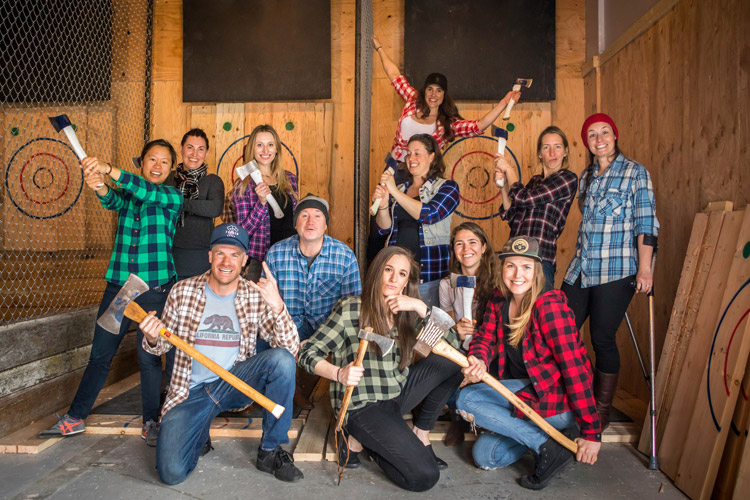Why Axe Throwing Denver Colorado Need To Get On Your Bucket Checklist
The Enjoyable of Axe Throwing: Exactly How This Sporting Activity Combines Ability and Adrenaline for a Fun Time
Axe throwing has arised as a captivating sporting activity that masterfully links the requirement for specific ability with the rush of adrenaline, offering participants a one-of-a-kind and appealing experience. The act of tossing an axe in the direction of a target demands focus and technique, at the same time promoting an environment of friendship and pleasant competition. This fascinating mix of psychological focus and physical effort has actually made axe throwing a popular choice for those seeking both recreation and a feeling of achievement. To truly appreciate the depth and allure of this activity, one need to consider its beginnings, the necessary tools, and the fundamental techniques that make certain both safety and satisfaction.
The Beginnings of Axe Throwing
Axe tossing, a recreational task that has gotten significant popularity in recent years, traces its origins back to ancient times. The earliest documents of axe usage in competitive contexts are discovered among the Celts and Vikings, who tossed axes for sport as well as in fight training.
Middle ages European warriors, especially throughout the Middle Ages, practiced axe throwing as part of their martial training. The Francisca, a sort of tossing axe utilized by the Franks, became famous for its lethal precision. This typical tool was developed to be tossed at enemy shields and armor, showcasing its twin energy in both sporting activity and fight.
In more recent history, axe tossing saw a revival in the logging camps of North America in the 19th and 20th centuries. Lumberjacks would engage in friendly competition, checking their precision and stamina by targeting at wooden targets. This development from a survival ability to an entertainment activity has led the way for its contemporary renewal, with specialized places and leagues now celebrating the sport internationally.
Devices You Required
Understanding the abundant history of axe tossing improves the admiration of the sporting activity's modern iteration. For competitive and entertainment axe throwing, the most commonly utilized type is the hatchet, generally weighing in between 1.25 to 2 extra pounds with a take care of size of about 16 inches.
Just as crucial is the target. Regulation targets are created from wood, with softwood varieties like ache or cottonwood being chosen for their capacity to absorb and hold the axe. The target is usually split into five concentric circles, each with a details point worth, to assist in rating.
Safety gear, however commonly overlooked, is essential. Protective handwear covers can improve grip and stop sores, while closed-toed footwear are a should to safeguard feet from dropped axes (axe throwing denver co). A well-lit, sizable tossing area, complete with security barriers, ensures a controlled environment where participants can focus on developing their skills.
Standard Techniques Explained
Understanding the essential strategies of axe throwing is essential for both safety and effectiveness. The initial strategy to understand is the grasp. Hold the axe with a company, yet loosened up grip, comparable to holding a golf club. The dominant hand ought to be positioned directly below the axe head, while the non-dominant hand supports the end of the manage.
Your leading foot must be somewhat ahead, straightening with your target. This positioning help in keeping stability and directing power accurately in the direction of the target.

Safety First
Making certain safety and security in axe throwing is vital to producing an injury-free and pleasurable experience. Precaution begin with the location layout. A properly designed axe tossing center attributes clear demarcations in between tossing lanes, durable backgrounds to catch stray axes, and non-slip flooring to stop crashes. Furthermore, appropriate lights is critical to assist participants preserve aesthetic precision and spatial awareness.
Benefits of Axe Throwing
Axe throwing deals a myriad of advantages that prolong past straightforward leisure. The repeated motion of throwing the axe also boosts hand-eye control and great electric motor abilities.
Psychologically, axe throwing needs precision, emphasis, and strategy, making it an outstanding way to develop cognitive skills. The focus needed to hit the target can serve as a form of mindfulness, enabling participants to clear their minds and decrease stress. This mental engagement can be specifically helpful in aiding people develop far better analytic skills and psychological durability.
Socially, axe throwing is frequently appreciated in group setups, fostering team-building and sociability. Whether as part of a company event or an informal outing with close friends, the sport urges communication and partnership. Furthermore, the common experience of learning and improving with each other can reinforce relationships and develop lasting memories.
Conclusion

The earliest documents of axe use in affordable contexts are discovered amongst the Celts and Vikings, who tossed axes for sport as read the article well as in combat training. Release the axe when your hands are about at eye level, enabling the axe's all-natural turning to guide it in the direction of the target.
A properly designed axe tossing center features clear separations in between throwing lanes, strong backdrops to capture roaming axes, and non-slip floor covering to stop accidents. Individuals need to be advised on the right way to take care of and toss the axe, emphasizing managed, intentional motions over powerful throws.
In summary, axe throwing stands out as a sport that masterfully incorporates adrenaline, ability, and accuracy.